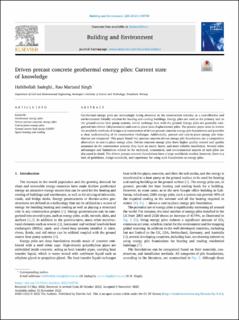| dc.contributor.author | Sadeghi, Habibollah | |
| dc.contributor.author | Singh, Rao Martand | |
| dc.date.accessioned | 2022-12-06T07:58:01Z | |
| dc.date.available | 2022-12-06T07:58:01Z | |
| dc.date.created | 2022-12-02T16:54:19Z | |
| dc.date.issued | 2023 | |
| dc.identifier.citation | Building and Environment. 2023, 228 . | en_US |
| dc.identifier.issn | 0360-1323 | |
| dc.identifier.uri | https://hdl.handle.net/11250/3035964 | |
| dc.description.abstract | Geothermal energy piles are increasingly luring attention in the construction industry as a cost-effective and environmental friendly solution for heating and cooling buildings. Energy piles are used as the primary unit in the ground source heat pump systems, which exchange heat with the ground. Energy piles are generally categorized into driven (displacement) and cast-in-place (non-displacement) piles. The present paper aims to review the available methods of design and construction of driven precast concrete energy pile foundations and provides a clear understanding of its construction challenges. Additionally, precast and cast-in-place energy pile foundations are compared. This paper found that precast concrete-driven energy pile foundations are a competitive alternative to cast-in-place energy piles. Driven concrete energy piles have higher quality control and quality assurance in the construction process; they have an easier, faster, and more reliable installation. Several other advantages and limitations related to the technical, economical, and environmental aspects of such piles are discussed in detail. The driven precast concrete foundations have a large worldwide market; however, there is a lack of guidelines, design standards, and experience for using such foundations as energy piles. | en_US |
| dc.language.iso | eng | en_US |
| dc.publisher | Elsevier | en_US |
| dc.rights | Navngivelse 4.0 Internasjonal | * |
| dc.rights.uri | http://creativecommons.org/licenses/by/4.0/deed.no | * |
| dc.title | Driven precast concrete geothermal energy piles: Current state of knowledge | en_US |
| dc.title.alternative | Driven precast concrete geothermal energy piles: Current state of knowledge | en_US |
| dc.type | Peer reviewed | en_US |
| dc.type | Journal article | en_US |
| dc.description.version | publishedVersion | en_US |
| dc.source.pagenumber | 109790 | en_US |
| dc.source.volume | 228 | en_US |
| dc.source.journal | Building and Environment | en_US |
| dc.identifier.doi | https://doi.org/10.1016/j.buildenv.2022.109790 | |
| dc.identifier.cristin | 2088007 | |
| cristin.ispublished | true | |
| cristin.fulltext | original | |
| cristin.qualitycode | 2 | |

